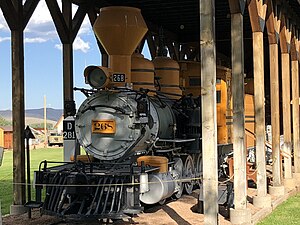Rio Grande 268
| D&RGW 268 | |||||||||||||||||||||||||||||||
|---|---|---|---|---|---|---|---|---|---|---|---|---|---|---|---|---|---|---|---|---|---|---|---|---|---|---|---|---|---|---|---|
 D&RGW 268 on display in Gunnison. | |||||||||||||||||||||||||||||||
| |||||||||||||||||||||||||||||||
| |||||||||||||||||||||||||||||||
| |||||||||||||||||||||||||||||||
| |||||||||||||||||||||||||||||||
Rio Grande 268 is a 2-8-0 "Consolidation" type narrow-gauge steam locomotive built for the Denver and Rio Grande Western Railroad by the Baldwin Locomotive Works in 1882. It is one of three surviving locomotives in D&RG class 60.
Early history
[edit]At the start of the 1880s, the Denver & Rio Grande was expanding rapidly.[4][5][6] Major lines extended south toward Santa Fe, southwest toward Silverton and west to the Utah state line.[7] As a result, the railroad placed several orders for 2-8-0s from Baldwin and Grant Locomotive Works. 268 was one of an order of 30 locomotives in August 1881, and was completed in January of the next year.[3][8]


268 spent most of its working life around Gunnison, Colorado, with an early photograph showing it in helper service on the mainline to Montrose.[7] Other early photographs show the engine in Salida and Alamosa.[9][10]

In the 1800s, D&RGW 268 and her sister engines were the premier motive power for the railroad, hauling passenger trains and top-priority freight trains.[11][5] Decades later, in the 20th century, the aging narrow-gauge engine was relegated to low-priority trains on secondary and branch lines.
Historic recognition and current status
[edit]As early as 1945, 268 was recognized for its historic significance when it featured on the Rio Grande's 75th Anniversary Tour.[12] Again in 1949, the engine was featured at the Chicago World's Fair, this time in a version of the road's diesel colors of yellow and silver with black stripes. The engine featured in the 1952 film Denver and Rio Grande before returning to ordinary service in the Gunnison area. The engine's final run for the D&RGW was in 1954. It was used by a contractor in 1955 to scrap branch lines out of Gunnison, Colorado.[11]
After its retirement, 268 was donated to the city of Gunnison, Colorado. It featured in Colorado's centennial celebrations in 1959, then moved to its current location at the Gunnison Pioneer Museum in 1964. [12] The engine today[when?] is cosmetically restored in its yellow and silver paint scheme.[5]
See also
[edit]References
[edit]- ^ Official Roster No. 11 of the Denver and Rio Grande Western Railroad System. Denver: The Denver and Rio Grande Western Railroad System. April 1, 1923.
- ^ "Denver & Rio Grande Locomotive History: 223". Rio Grande Modeling and Historical Society. Retrieved 28 January 2010.
- ^ a b Baldwin Locomotive Works Engine Specifications, Vol. 11. Philadelphia: The Baldwin Locomotive Works. 22 August 1881. p. 33. Retrieved 28 February 2024.
- ^ Athearn, Robert G. Rebel of the Rockies: The Denver & Rio Grande Western Railroad, pp. 98-123, Yale University Press, New Haven, Connecticut, 1962.
- ^ a b c Day, Jerry B. “History of D&RGW Locomotive Number 268,” p. 3, The Prospector, Volume 2, Number 3, Third Quarter 2003, The Rio Grande Modeling & Historical Society, Colorado Springs, Colorado.
- ^ Danneman, Herbert. A Ticket to Ride the Narrow Gauge, pp. 29-56, Colorado Railroad Museum, Golden, Colorado, 2000. ISBN 0-918654-24-6.
- ^ a b Ferrell, Mallory (2018). Denver & Rio Grande: The Early Years. Bucklin, Missouri: White River Productions. pp. 105–111, 151–157, 209. ISBN 978-1932804416.
- ^ Baldwin Locomotive Works, Index of Companies, Construction Numbers from March 1880 to May 1889, Nos. 5000 to 9999. Philadelphia: Baldwin Locomotive Works. 1889. p. 35. Retrieved 28 February 2024.
- ^ "Photograph of Salida, Colorado". Denver Public Library Digital Collections. Retrieved 28 February 2024.
- ^ Perry, Otto. "D&RGW locomotive (Narrow Gauge), engine number 268, engine type 2-8-0". Denver Public Library Digital Collections. Retrieved 28 February 2024.
- ^ a b Day, Jerry B. “Rio Grande’s Grant-Built C-16 Number 223,” p. 3, The Prospector, Volume 4, Number 1, First Quarter 2005, The Rio Grande Modeling & Historical Society, Colorado Springs, Colorado.
- ^ a b "Railroad Exhibits". The Gunnison Pioneer Museum. Retrieved 28 February 2024.
